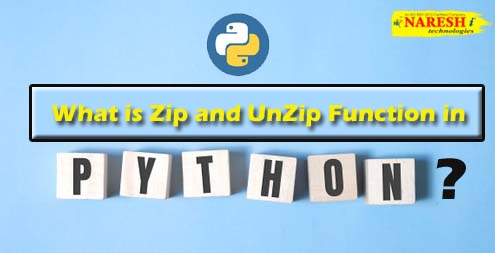Introduction :
- The Python is a popular programming language created by Guido van Rossum, and released in the year 1991.
- Python is more powerful language which offer great tools for data crunching and preparation, as well as for complex scientific data analysis and modelling.
- Python today has multiple implementations including Jython, scripted in Java language for Java Virtual Machine.
- IronPython is the new variety which is written in C# for the Common Language Infrastructure, and PyPy version written in RPython and translated into C.
- Most of the Python modules work on community development model and are open-source and free.
Zip Function in Python :
- The zip() function in python is basically used to returns a zip object.
- The zip object is basically an iterator of tuples.
- Here in the iterator the first item or value in each passed iterator is paired together, and then the second item in each passed iterator are paired together etc.
- During the process if the passed iterators have different lengths, the iterator with the least items decides the length of the new iterator.
Syntax :
zip(iterator1, iterator2, iterator3 …)
Note : Here the Iterator objects that will be joined together.
Example :
We can have the following example which shows that how the zip function is being used in the Python. Here it should be noted that If one tuple contains more items, these items are ignored.
a = (“John”, “Charles”, “Mike”)
b = (“Jenny”, “Christy”, “Monica”, “Vicky”)
x = zip(a, b)
Zip in Python 3 :
As you know that the Python released version 3.0 which is also called as Python 3 on December 2008. Technically this version was mainly released in order to fix the major problems which are get found in Python 2. As you know that the Python 3 was incompatible with Python 2 in many aspects. It is backward incompatible and Some features of Python 3 have been backported to Python 2.x versions to make the migration process easy in Python 3.
When we are going to consider the zip function utility the Python 3 doesn’t have any many differences in terms of syntax but yes in terms of values it does have. Let us consider the following example which will let you know how the zip function is get applied in Python3.
Syntax :
zip(*iterators)
Parameters :
Here the Python iterables or containers that we used to have are( list, string etc ).
Return Value :
It is used to returns a single iterator object which is used to contains the mapped values from all the containers which are present.
Example :
# Python code to demonstrate the working of zip()
# initializing lists
name = [ “Manjeet”, “Nikhil”, “Shambhavi”, “Astha” ]
roll_no = [ 4, 1, 3, 2 ]
marks = [ 40, 50, 60, 70 ]
# using zip() to map values
mapped = zip(name, roll_no, marks)
# converting values to print as set
mapped = set(mapped)
# printing resultant values
print (“The zipped result is : “,end=””)
print (mapped)
Note : If we are going to compare with Python2 and Python3 then you will find the similarity in maximum cases.
Unzipping in Python :
Like similar to zip() the Unzipping is also get implemented. The Unzipping operation in Python means we are going for converting the zipped values back to the individual self as they were initially before the zip() was get applied. This is done with the help of “*” operator.
Let us consider the following example which will let you know how the unzipping will work. Here I am going to consider the same example which I have taken in the zip() implementation so that you can easily understand the zip() and unzip().
Example :
# Python code to demonstrate the working of unzipping
# First we need to initialise the lists
name = [ “Manjeet”, “Nikhil”, “Shambhavi”, “Astha” ]
roll_no = [ 4, 1, 3, 2 ]
marks = [ 40, 50, 60, 70 ]
# using zip() to map values
mapped = zip(name, roll_no, marks)
# converting values to print as list
mapped = list(mapped)
# printing resultant values
print (“The zipped result is : “,end=””)
print (mapped)
print(“\n”)
# unzipping values
namz, roll_noz, marksz = zip(*mapped)
print (“The unzipped result: \n”,end=””)
# printing initial lists
print (“The name list is : “,end=””)
print (namz)
print (“The roll_no list is : “,end=””)
print (roll_noz)
print (“The marks list is : “,end=””)
print (marksz)
Note :
It should be get noted that there are many possible applications are present that can be said to be expected using zip.
We are having many relevant examples where we are going to apply such functionality in wider range. For example, student database or scorecard or any other utility that requires mapping of groups.
Scope @ NareshIT :
- At Naresh IT you will get a good Experienced faculty who will guide you, mentor you and nurture you to achieve your dream goal.
- Here you will get a good hand on practice in terms of practical industry-oriented environment which will definitely help you a lot to shape your future.
- During the designing process of application, we will let you know about the other aspect of the application too.
- Our Expert trainer will let you know about every in’s and out’s about the problem scenario.
Achieving your dream goal is our motto. Our excellent team is working restlessly for our students to click their target. So, believe on us and our advice, and we assured you about your sure success.


